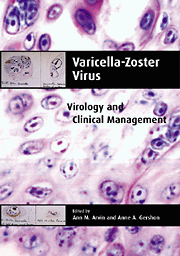Book contents
- Frontmatter
- Contents
- List of contributors
- Preface
- Introduction
- Part I History
- Part II Molecular Biology and Pathogenesis
- Part III Epidemiology and Clinical Manifestations
- 10 Epidemiology of varicella
- 11 Clinical manifestations of varicella
- 12 Epidemiology of herpes zoster
- 13 Clinical manifestations of herpes zoster
- 14 Ophthalmic zoster
- 15 Postherpetic neuralgia and other neurologic complications
- 16 Varicella and herpes zoster in pregnancy and the newborn
- Part IV Laboratory Diagnosis
- Part V Treatment and Prevention
- Index
- Plate section
11 - Clinical manifestations of varicella
from Part III - Epidemiology and Clinical Manifestations
Published online by Cambridge University Press: 02 March 2010
- Frontmatter
- Contents
- List of contributors
- Preface
- Introduction
- Part I History
- Part II Molecular Biology and Pathogenesis
- Part III Epidemiology and Clinical Manifestations
- 10 Epidemiology of varicella
- 11 Clinical manifestations of varicella
- 12 Epidemiology of herpes zoster
- 13 Clinical manifestations of herpes zoster
- 14 Ophthalmic zoster
- 15 Postherpetic neuralgia and other neurologic complications
- 16 Varicella and herpes zoster in pregnancy and the newborn
- Part IV Laboratory Diagnosis
- Part V Treatment and Prevention
- Index
- Plate section
Summary
Introduction
Varicella is a highly contagious disease of childhood. Virus is spread by the airborne route from the skin lesions and oropharynx of infected individuals to susceptible contacts (Thomson, 1919; Leclair et al., 1980; Gustafson et al., 1982). Secondary clinical attack rates in susceptible siblings after a household exposure to varicella are as high as 90% (Ross et al., 1962) and may also be high in closed populations of children such as schools (Wells & Holla, 1950). Humans are the only natural host for this virus, although there is one report of a gorilla in captivity contracting varicella from a handler with lesions (Myers et al., 1987). This chapter reviews the clinical manifestations of varicella in healthy and immunocompromised patients.
Pathogenesis
After contact with the mucosa of the upper respiratory tract or the conjunctiva, the virus invades and is thought to replicate in the local lymphoid tissue. Four to 6 days later, a small primary viremia results in spread to reticuloendothelial cells in the liver, spleen and other organs, where there is further replication until 10 to 12 days after exposure (1–2 days before development of rash). At that time, a more significant secondary viremia results in spread of the virus to the skin. Varicellazoster virus (VZV) has been isolated from human mononuclear cells up to 5 days prior to onset of rash (Asano et al., 1985a,b). It is during this secondary viremic phase that the prodromal symptoms of fever, malaise, and irritability are seen and herald the onset of rash. These prodromal symptoms are more pronounced in adolescents and adults than in children, who may have no prodrome.
- Type
- Chapter
- Information
- Varicella-Zoster VirusVirology and Clinical Management, pp. 206 - 219Publisher: Cambridge University PressPrint publication year: 2000
- 6
- Cited by



